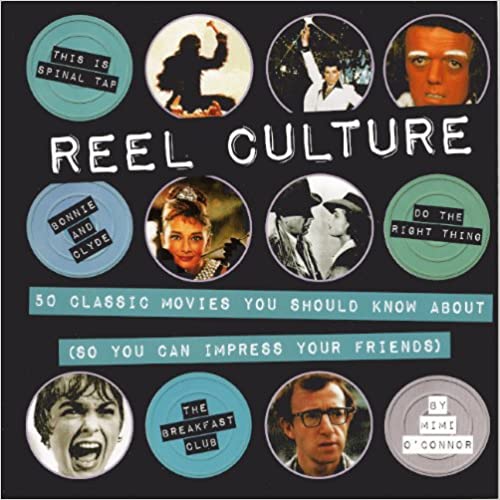
Reel Culture: 50 Classic Movies You Should Know About (So You Can Impress Your Friends) by Mimi O’Connor is an interesting primer for budding film buffs. The 50 films chosen are not obscure in any way, and have definitely stood the test of time. As the author puts it in her foreward: “Classic film references seep into pop culture in ways that many people are not aware of. Once you come to know these films, you will be amazed at how many jokes and references you will suddenly get.”
Reel Culture is published by Zest Books, who have carved out a neat little niche in the teen market. But Reel Culture is not strictly for teens, I found plenty of interesting items in the book. The 50 films chosen span the years 1938-1991. I like the fact that Mimi stopped 21 years ago, because as she puts it, “Later movies are not ‘classics’ – yet.” Good call.
The first entry surprised me a bit, it is the 1938 Cary Grant – Katherine Hepburn “screwball” comedy, Bringing Up Baby. The final choice has unquestionably reached “classic” status, The Silence of the Lambs (1991). So we have a 53-year parameter, and it is pretty hard to argue with the movies picked. Of course, this book could have easily been expanded to 100, or even 200 – but the author keeps it light on purpose.
Most of these are pretty obvious picks. Remember, the premise is not necessarily box-office hits, but films which (for various reasons) are considered classics. So the inclusion of The Wizard of Oz (1939) Citizen Kane (1941), Easy Rider (1969), The Godfather (1972) and Apocalypse Now (1979) come as no surprise.
What I found most intriguing are the not-so obvious choices. A few of these are Rear Window (1954), Planet of the Apes (1968), Willy Wonka and the Chocolate Factory (1971), and Airplane! (1980). Not that I disagree with any of these choices, mind you. I applaud the inclusion of Hitchcock, whose Psycho (1960) is also discussed.
I was especially pleased to see the original Gene Wilder Willy Wonka here. In my family, that movie was considered every bit the equal of The Wizard of Oz. One of the funniest quirks of my now 23 year-old daughter has towards it is the fact that she absolutely refuses (still) to watch the Tim Burton version, Charlie and the Chocolate Factory (2005). She was incensed that they would even consider remaking the picture.
Reel Culture follows a fairly simple format. Each movie is given about three pages. Let’s use Stanley Kubrick’s A Clockwork Orange (1971) as an example. On the first page, O’Connor lays out the basic plotline, with sidebars as to who stars in it, and more by the director. By the way, Kubrick is well-represented in Reel Culture, as both 2001: A Space Odyssey (1968) and The Shining (1980) are also included.
The second page is titled “Why All the Fuss?” In the case of Clockwork, there are seven bullet points, the first of which is “It is a really sinister mix of violent realism, and bizarre sci-fi futuristic fable.” The third page also has a title, “The Stuff People Still Talk About.” There are four main points O’Connor has about Clockwork, including the clothing, the murder scene with the ceramic penis, Alex’s rehabilitation, and Alex’s love of Beethoven. There is also a box with quickie facts about the movie, such as whether or not it was nominated (or won) any Academy Awards.
Even as a bit of a film-buff myself, I was unaware of what William Friedkin said at the 1972 Awards ceremony. His French Connection won Best Picture that year, and in his acceptance speech he praised Kubrick as the best director of the year. Pretty cool. There are also representative stills from the movies in question, and a couple of classic quotes.
Basically, all 50 films follow this format. It makes for a quickie read, with some fun facts one may or may not have been previously aware of. If nothing else, Reel Culture is a fine place for younger film fans to begin getting to know the long and storied history of the medium.